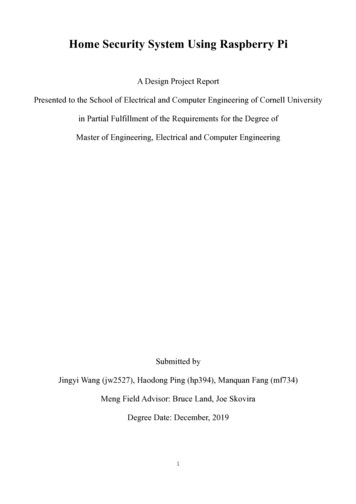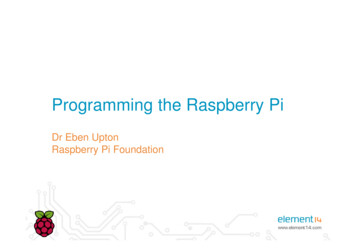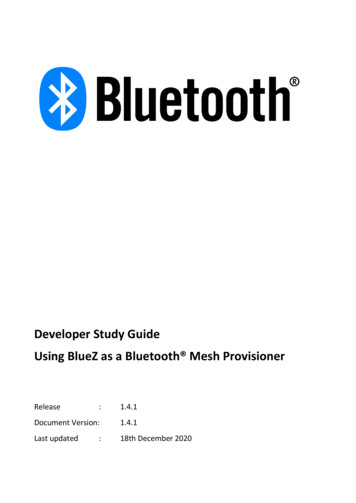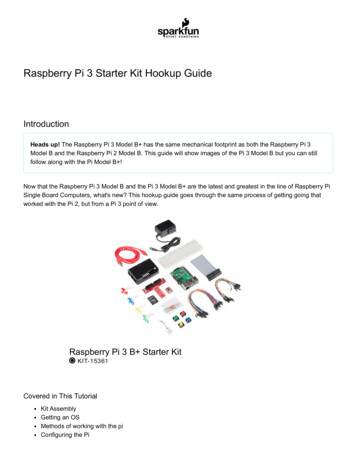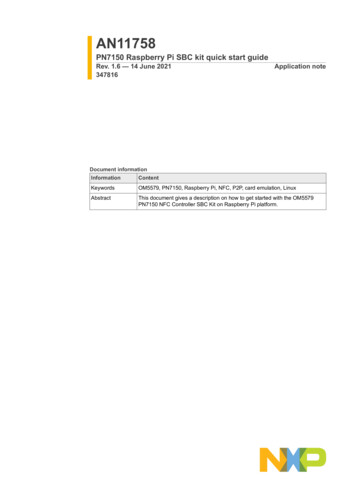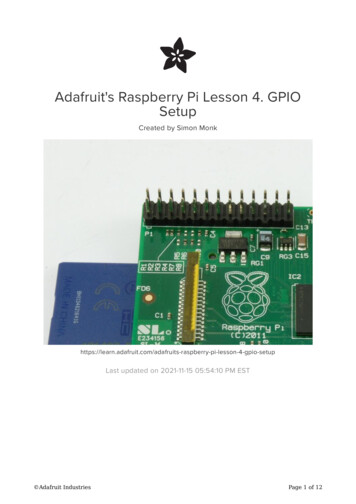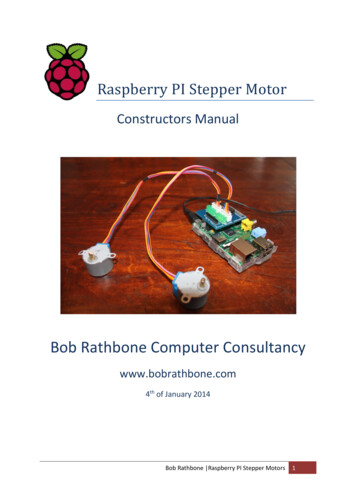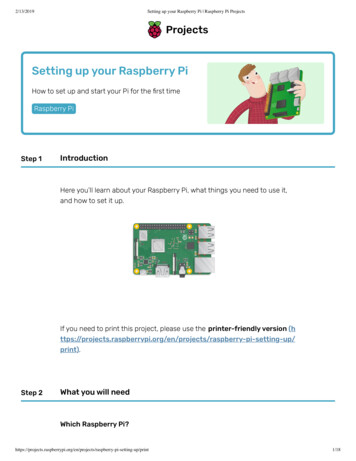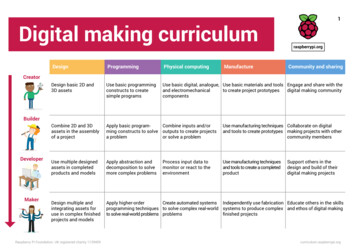
Transcription
Digital making mingPhysical computingCommunity and sharingDesign basic 2D and3D assetsUse basic programmingconstructs to createsimple programsUse basic digital, analogue, Use basic materials and tools Engage and share with theand electromechanicalto create project prototypesdigital making communitycomponentsCombine 2D and 3Dassets in the assemblyof a projectApply basic programCombine inputs and/orming constructs to solve outputs to create projectsa problemor solve a problemUse manufacturing techniques Collaborate on digitaland tools to create prototypes making projects with othercommunity membersUse multiple designedassets in completedproducts and modelsApply abstraction anddecomposition to solvemore complex problemsUse manufacturing techniquesand tools to create a completedproductDesign multiple andintegrating assets foruse in complex finishedprojects and modelsApply higher-orderCreate automated systems Independently use fabrication Educate others in the skillsprogramming techniques to solve complex real-world systems to produce complex and ethos of digital makingto solve real-world problems problemsfinished projectsCreatorBuilderDeveloperMakerRaspberry Pi Foundation. UK registered charity 1129409Process input data tomonitor or react to theenvironmentSupport others in thedesign and build of theirdigital making projectscurriculum.raspberrypi.org
DesignDesign basic 2D and 3D assets.Learners can use basic design principles to producesimple graphics, videos, circuit schematics, formattedweb pages, cutting sheets, and 3D model components,utilising CAD and graphics software, or markup languages.Example outcome Can use CAD tools to create simple 2D designs for projects Can use a markup language to create and style text and images fora webpage Can use graphical applications to manipulate bitmap and vector imagesExample projects Robot antenna (Scratch, Raspberry Pi) Pixel pet (Python, Sense HAT) Build a robot (HTML / CSS) Stickers (HTML / CSS) Cat meme generator (HTML /CSS/JavaScript)ManufactureUse basic materials and tools to createproject prototypesProgrammingPhysical computing2Use basic programming constructsto create simple programsUse basic digital, analogue, andelectromechanical componentsLearners can write short programs demonstratingawareness of simple programming concepts, such assequencing, repetition, variables, and selection.Learners can write programs which use active andpassive electronic components. They can receive datafrom input components and control output componentsusing a computer or microcontroller.Example outcomes Can use simple control flow statements Can use variables and simple data structures Can use a variety of logical, arithmetic, and comparison operatorsExample projects Lost in space (Scratch) Ghostbusters (Scratch) Chatbot (Scratch) Story time (Python) Turtle race (Python)CreatorExample outcomes Can design and construct simple prototype circuits usingcomponents connected directly to GPIO pins Can recognise and use polar components, such as LEDs andcapacitors Can write programs to read data from digital and analogueinputs and to control digital and analogue outputsExample projects Whoopi cushion (Python, Raspberry Pi) Spinning flower wheel (Python, Raspberry Pi, Explorer HAT) Burping jelly baby (Python, Raspberry Pi) Frustration (BBC micro:bit)Community and sharingEngage and share with the digitalmaking communityLearners can use tools to cut, measure, and join materials,and use bonding agents where appropriate, to producesimple parts for prototype projects. They can produceprototype circuits, following simple circuit schematics.Learners interact with other members of the community, andshare their creations. They may attend events and meetups,or interact with other community members online.Example outcomes Can create simple circuits, using a breadboard and jumperleads or crocodile clips Can use and manipulate upcycled materials for use in prototypes Can repurpose commercial products for use in project prototypesExample outcomes Share a digital creation with the wider community Participate in an event within the wider community Engage in an online discussion about a digital making project Understand the importance of not sharing personally identifiable information onlineExample projects Cress egg heads (Python, Raspberry Pi, Pi Camera) Tweeting Babbage (Python, Raspberry Pi) Whoopi cushion (Python, Raspberry Pi)Example projects Username generator (Scratch) Use safe online sharing platforms to showcase their digital creations Attend a Raspberry Jam and listen to some talks or attend a workshop Visit their local makerspace and learn from others in the communityRaspberry Pi Foundation. UK registered charity 1129409curriculum.raspberrypi.org
DesignProgrammingPhysical computing3Combine 2D and 3D assets in the assemblyof a projectApply basic programming constructs tosolve a problemCombine inputs and/or outputs to createprojects or solve a problemLearners can design 2D and 3D assets for use in projects,using CAD and graphics software or markup languages.They can independently produce simple graphics, video,circuit schematics, formatted web pages, cutting sheets,and 3D model components for a project.Learners are able to develop algorithms that make useof basic programming constructs to satisfy predefinedoutcomes or project briefs.Learners can write programs that use active and passiveelectronic components in combinations with one another.They can receive data from input components, performlimited data processing, and control multiple output components using a computer or microcontroller.Example outcomes Can use simple video editing tools to manipulate footage Can use HTML, CSS, and JavaScript to produce browser-based content Can use CAD tools to produce component parts for 3D structuresExample projects Create a sprite with an animated walk cycle for use in a computer game Create a website to showcase a digital making project Create a 3D model of a physical make to demonstrate its plannedappearance and dimensionsManufactureUse manufacturing techniques and tools tocreate prototypesLearners can choose and manipulate appropriate materialsfor use in their finished prototypes. They can use a varietyof techniques and tools to accurately cut, measure, andmanipulate materials. They can construct circuits bysoldering to prototyping boards.Example Outcomes Can create soldered circuits using stripboards or protoboards Can use tools to manipulate materials and create componentparts for a prototype Can use a multimeter to debug circuitsExample Projects Getting started with wearables (C , Adafruit FLORA) See like a bat (Python, Raspberry Pi)Raspberry Pi Foundation. UK registered charity 1129409Example outcomes Can create subroutines/procedures/functions in their programs Can programmatically read and manipulate a data structure Can use standard communication protocols and APIs to transferdata between computers and applicationsExample orojects Dodgeball (Scratch) Create your own world (Scratch) Secret messages (Python) Turtley amazing (Python) Hamster party cam (Python, Raspberry Pi, Camera Module, ExplorerHAT)BuilderExample outcomes Can use sensors to trigger real-world outputs, such as camerasand electromechanical devices Can use combinations of input and output components to transferdata between systems Can use transistors and relays to power components requiring higher voltagesExample projects Raspberry Pi Zero time-lapse camera (Python, Raspberry Pi,Camera Module) Making a laser tripwire with a Raspberry Pi (Raspberry Pi) GPIO Music box (Python, Raspberry Pi)Community and sharingCollaborate on digital making projects withother community membersLearners collaborate on projects with other members of thecommunity. This could be face-to-face or online, in eitherformal or informal settings.Example Outcomes Collaborate in a digital make with other people Participate in a digital making event with others in the community Be aware of data privacy rules and guidelines for the safe sharing ofinformation onlineExample Projects Password generator (Python) Create a project with another member of their Code Club/CoderDojo/etc. Team up with some friends and go to a hackathon Find someone from the community who has made a project similar totheirs, and ask them for help in their makecurriculum.raspberrypi.org
DesignProgrammingPhysical computing4Use multiple designed assets in completedproducts and modelsApply abstraction and decomposition tosolve more complex problemsProcess input data to monitor or react tothe environmentLearners can design assets in a variety of media, and combinethose assets into finished products. They can independentlyproduce graphics, video, circuit schematics, interactivewebpages, cutting sheets, and 3D models which meet adesign brief.Learners are able to work on larger problems. They areable to simplify and break down larger problems, makinguse of abstraction and decomposition, as well as morecomplex reusable data structures.Learners can use a computer or microcontroller to designand write programs to process data from external sourcesand to control output devices that react to, or alter, theirenvironment. They can design and write programs tomonitor various aspects of an environment.Example outcomes Can use CAD software to design circuits and PCBs Can use CAD software to design 2D components to be laser cutand perfectly assembled Can use CAD software to design 3D models and components to be3D printed and assembledExample projects Create a 2D design for the components of a simple box to be usedin a laser cutter Create files for a 3D body of a robot which can be used in a 3D printer Produce a design for a PCB which can be etched or sent for fabricationManufactureUse manufacturing techniques and tools tocreate a completed productLearners can use industry-standard prototyping andmanufacturing techniques, such as 3D printing, lasercutting, and PCB etching, to produce and assemblecomponents to be used in their finished projects.Example outcomes Can decompose a large problem into parts and design algorithmsto solve them Can recognise similar problems, and apply generic solutionsand abstractions Can effectively combine functionality from multiple librariesor APIs and refer to documentation Can write code in a readable way and/or comments where necessaryExample projects Dress for the weather (Python) Flappy astronaut (Python, Raspberry Pi, Sense HAT) Getting started with the Twitter API (Python)DeveloperExample outcomes Combine and process data from multiple sources to build areal-time system Use, and extrapolate values from, input data to makepredictions about a system Use output devices to react to live dataExample projects Parent detector (Python, Raspberry Pi, Camera Module) Sense HAT marble maze (Python, Raspberry Pi, Sense HAT) Sense HAT Minecraft map (Python, Raspberry Pi, Sense HAT)Community and sharingSupport others in the design and build oftheir digital making projectsLearners offer support and assistance to other members ofthe community. They create content which other communitymembers can follow to create projects.Example outcomes Use cutting tools and joining/bonding techniques to create afinished product Solder components to PCBs and test circuits using a multimeter Can manufacture products which integrate with existing systemsExample outcomes Assist others in a digital make, either online or in person Produce learning materials to guide others in a digital make Produce and maintain code that is shared through on onlineversion control platform Contribute to a community project Give appropriate credit when making use of others’ workExample projects 3D Printed Astro Pi flight case (Raspberry Pi, Camera Module,Sense HAT, 3D printer) Use MDF and wood glue to produce a concealed housing for aburglar alarm 3D print a decorative ornament that contains flashing LEDsExample projects Getting started with Git Create a YouTube tutorial for their project Join their local makerspace and help others with their digital makes Give a talk at a developer conference, a Raspberry Jam, or a maker meetupRaspberry Pi Foundation. UK registered charity 1129409curriculum.raspberrypi.org
DesignProgrammingPhysical computing5Design mu ltiple and integrating assets foruse in complex finished projects and modelsApply higher-order programming techniquesto solve complex real-world problemsCreate automated systems to solvecomplex real-world problemsLearners can design a range of assets in a variety ofmedia, to be used in projects and models that solve realworld-problems. They can analyse a problem and thenproduce graphics, videos, circuit schematics, interactiveweb pages, cutting sheets, and 3D models that assist insolving that problem.Learners are able to make use of a variety of programmingparadigms, and combine data from various systems tosolve complex, real-world problems.Learners can analyse a real-world problem and designand create automated systems that monitor, react to, orinfluence an environment to solve the problem.Example outcomes Can use a variety of programming paradigms in their programs, choosing techniques appropriate to the problem at hand Can implement and use a variety of more complex data structures in their programs, such as trees, graphs, and setsExample outcomes Process multiple data and/or input sources, and use them to controlmultiple and interconnected output devices Use online data sources and inputs to control output devices Publish data from sensors on an online platform and display thedata graphicallyExample projects Create an importable module that interacts with the MinecraftAPI, allowing the easy construction and manipulation of largestructures Create an automated maze generator for producing differentlysized mazes that are suitable for displaying on an LED matri Create a web-based front end for a HAB balloon, where sensordata received via radio is displayed in real timeExample projects Create a system which monitors and controls the environment ofliving things such as fish or plants Create a system which monitors local weather conditionsand warns people of impending bad weather Produce a mechanical arm which can be monitored and controlledover the internetExample outcomes Use PCB design tools to create PCBs that conform to appropriatedimensions and component positioning Use CAD tools to design housings and component parts whichintegrate into a finished product Use graphics and video editing tools to produce completeaudiovisual products Give thought to user interaction and accessibilityExample projects Produce a detailed character sheet for use in a graphical computer game Produce a 3D model of a character that can be imported into a game engine Produce a dynamic website that displays data harvested from an APIManufactureIndependently use fabrication systems toproduce complex finished projectsLearners can appropriately combine a variety of industry-standard manufacturing techniques to independentlyproduce and assemble components for a finished project.Example outcomes Use a 2D cutter to produce 2D components for assembly Use a 3D printer to produce a completed product or components foran assembly Use exposure and etching techniques to produce custom PCBsExample projects Grandpa scarer (Python, Raspberry Pi) Print a 3D housing for a Pi Zero Game Boy clone Produce a custom PCB for an automated pet feederRaspberry Pi Foundation. UK registered charity 1129409Community and sharingMakerEducate others in the skills and ethos ofdigital makingLearners take on an educator or mentor role to assist in thelearning of other community members. They may take part inworkshops and seminars, or inspire others through educatorfocused volunteering.Example outcomes Regularly assist others in their digital making experiences Educate or assist large groups of individuals in their digital makes Regularly publish learning materials for use by the community Make code and data openly available (using an appropriate licence)for use by other community members Ensure all gathered data complies with local data protection lawsExample projects Write tailored resources that meet the needs of a particular audience,e.g. children attending a Code Club Become a volunteer at Code Club, CoderDojo, or Pioneers Run a workshop at a Raspberry Jam or a conferencecurriculum.raspberrypi.org
6Computational thinkingOne of the aims of the Raspberry Pi Foundation is to help people to learn about computer science and how to make thingswith computers. We believe that learning how to create, control, and contrive technology will help people shape an increasinglydigital world and prepare them for work of the future.Computational thinking is at the heart of the learning that we advocate. It is the thought process that underpinscomputing and digital making: formulating a problem and expressing its solution in such a way that a computer can effectivelycarry it out. Computational thinking covers a broad range of knowledge and skills, including but not limited to: Logical reasoningAlgorithmic thinkingPattern m solvingBy progressing through our curriculum, learners will develop computational thinking skills and put them into practice.Raspberry Pi Foundation. UK registered charity 1129409curriculum.raspberrypi.org
GlossaryA7abstraction Representing a concept by omitting unnecessary details, focussing only on the aspects which are importantactive sensor Sends a signal and then detects changes in the environment based on the data returned, usually requires an externalpower sourcealgorithm A series of precise instructions to solve a problemanalogue signal A continuous variable signalAPI Application programming interface, a set of functions used when building softwareassets Items needed to create a project, such as images or 3D-printed partsBbonding agent Adhesive for sticking components together (e.g. glue)breadboard A reusable circuit board for prototyping electronic circuitsCCAD Computer-aided design. Allows precise 2D and 3D drawings and models of real-world objects to be designed on a computercircuit A path along which current flowscomputational thinking A set of mental skills that help to define a problem in such a way that a computer can solve itcontrol flow The order in which a computer executes instructionsDdata structure A format for storing and organising data (e.g. an array)decomposition Breaking a problem down into smaller, more manageable partsdigital signal A signal that is either on or offdigital making Creative projects requiring technical skill and understandingRaspberry Pi Foundation. UK registered charity 1129409curriculum.raspberrypi.org
GlossaryGGPIO General-purpose input/output, pins connected to the Raspberry Pi which can be controlled with codeIinput Data entered into a program (e.g. a mouse click)Mmarkup language A language specifying the presentation and style of text8microcontroller A small computer using a single chipOoutput Data sent out by a program (e.g. sound from a speaker)Ppassive sensor Detects changes in the environment without actively sending out a signal (e.g. a PIR sensor)PCB Printed circuit board, a board connecting electronic componentsprogramming paradigm A style or way of thinking about programming (e.g. object-oriented)protoboard Allows you to add components to a prototype circuit by soldering or cutting stripsRrepetition Executing the same code multiple times (while/for loops)Sschematic A diagram or plan representing a circuitselection Choosing which code to execute based on a condition (if/else)sequencing Executing lines of code one after anothersubroutine A named set of instructions in a program (also referred to as a function/procedure)Uupcycle Using materials which otherwise would be thrown away in order to make something of valueVvariable A named area in memory where data is storedRaspberry Pi Foundation. UK registered charity 1129409curriculum.raspberrypi.org
Example projects Raspberry Pi Zero time-lapse camera (Python, Raspberry Pi, Camera Module) Making a laser tripwire with a Raspberry Pi (Raspberry Pi) GPIO Music box (Python, Raspberry Pi) Builder. 4 Raspberry Pi oundation. U registered charity 1124 curriculum.raspberrypi.org Design
